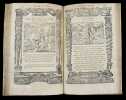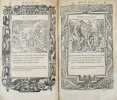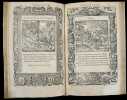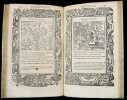ALCIAT, Andrea
Emblemata.
Lyon, Guillaume Rouillé, 1564.
Reference : 17280
Le premier livre d'emblèmes publié. Juriste et poète italien, Andrea Alciati envoya à Augsburg, une série d'épigrammes afin d'être publiée. Son éditeur eut alors l'idée de les illustrer. Un succès immédiat et durable, et le titre d'Emblemata a donné son nom à ce genre de livres. Edition illlustrée par un titre gravé et 211 bois gravés par Pierre Vase dans de très beaux encadrements. La traduction est de Barthelemy Aneau, avec ses commentaires. Le papier est bruni. Bon exemplaire. /// In-8 de 226, (4) pp. Vélin. (Reliure de l'époque //// First book of emblems published. Italian jurist and poet, Andrea Alciati sent to Augsburg, a series of epigrams to be published. His publisher then had the idea to illustrate them. An immediate and lasting success, and the title of Emblemata gave its name to this kind of books. Title-page within Renaissance woodcut border and 211 woodcuts of emblems all within splendid borders of varying design : some bear the monogram P. V.(ase). The translation is by Barthelemy Aneau, with his commentaries. The paper is browned. A good copy. Landwer, Romanic emblem books 68. /// PLUS DE PHOTOS SUR WWW.LATUDE.NET
Bookseller's contact details
Hugues de Latude
Hugues de Latude
B.P. 70046
31290 Villefranche de Lauragais
France
06 09 57 17 07
Payment mode



Sale conditions
Books are guaranteed to be complete and in good condition unless otherwise stated.
5 book(s) with the same title
Emblemata Florentii Schoonhovii I.C. Goudani, Partim Moralia partim etiam Civilia. Cum latiori eorundem ejufdem Auctoris interpretatione. Accedunt et alia quaedam Poëmatia in alijs Poema : tum fuorum libris non contenta.
LVGDVNI BATAVORUM, Ex officina Elzeviriana, 1726., (1 bl), titre, (3) portrait de l'auteur, 255 pp., (1bl). In-4 en plein vélin d'époque.
Un emblemata très rare, illustré de 74 magnifiques gravures sur cuivre placées en exergue de chaque devise, aussi étranges que délicates dans leur composition. Séduisant exemplaire dans sa reliure en vélin de l'époque.
Emblemata elucidata doctissimis Claudij Minois Commentarijs: Quibus additae sunt eiusdem Auctoris Notæ Posteriores.suivi de: Notæ posterioresad Alciata emblemata per Claudium Minoem
A Lugduni, Gulielmi Rouillij, 1614. Fort in-12 (17 x 11 cm) reliure plein velin du temps, titre manuscrit sur le dos, Lyon, Apud Hæredes Gulielmi Rouillii, 1614. Lyon, Apud Hæredes Gulielmi Rouillii, 1614. In-8, plein vélin du temps (un mors int. dét.), 20 f. non ch., 818 p., 11 f. (index). Illustré de 213 d'emblèmes gravées in-texte
Andrea Alciato (ou Alciati), connu sous le nom d'André Alciat en français et d'Andreas Alciatus en latin, (1492 - 1550) jurisconsulte et écrivain italien de langue latine, émule d'Ulrich Zasius et de Guillaume Budé. Il fut l'un des premiers représentants du courant dit de l'humanisme juridique. Il était un correspondant d'Érasme. Ses Emblemata s’inspirent des Adages d'Érasme pour leur composition en forme de collection et pour leur constante référence à l’antiquité. Les deux recueils connurent un vif succès dès leur parution et fournirent aux hommes de la Renaissance des modèles et des clés qu'ils allaient utiliser dans leur vie intellectuelle et sociale. Son œuvre la plus connue sont les Emblèmes (Emblemata), recueil d'allégories en vers latins sur des sujets moraux, qui eut beaucoup de succès en Europe.
Emblemata Amatoria. Emblèmes d'Amour en Quatre langues.
Amsterdam, A Londe chez l'Amoureux, c. 1682-1690. In-12 de (4) ff. (frontispice et titre-frontispice, dédicace et sonnet) 88 ff. imprimés sur un seul côté dont 44 planches numérotées avec leur explication en regard, demi-chagrin rouge, dos orné à nerfs (reliure du XIXe siècle).
Première édition quadrilingue des Emblemata Amatoria gravée par Jan van Vienen (1660?-1726?), complète des 44 planches gravées et numérotées, dont les numéros 30 à 40 sont signés J.v.V. (pour Jan van Vianen) - établie d'après Amorum Emblemata de Vaenius, Ambacht van Cupido de Heinsius (1613) et Tronus Cupidinis (c. 1616).Texte explicatif des emblèmes d'après Vaenius gravé en regard, en latin, italien, français et néerlandais. Feuillets liminaires : titre-frontispice gravé par Jan van Vianen suivi par "De Liefde aan de Juffers Klinkdicht" et frontispice "L'Amour aux Dames" d'après Vaenius (Amorum Emblemata 1608) avec le sonnet éponyme en regard.Landwehr situe l'impression vers 1682, antérieure selon lui à l'édition anglaise gravée par Ayres en 1683, tandis que Mario Praz la date vers 1690.Ex-libris "Biblioteca de D. Francisco Domecq Victor Cadiz 1852".Landwehr, 267 ; Mario Praz, Studies in seventeenth-century imagery, p. 323 : « Scarce ».
EMBLEMATA Cum Commentariis
Paris imprimerie de Jean Richer 1602 in 12 (18x11,5) 1 fort volume reliure plein vélin restauré, dos à nerfs, la page de titre manque, 23 feuillets liminaires non chiffés, 968 pages, et feuillets d'index rerum non chiffrés in fine, illustré de 230 gravures sur bois à mi-page, mouillures claires sur plusieurs cahiers du texte (parfois marginales)
Assez bon Couverture rigide
Emblemata Evangelica Hans Bol
BE, Erfgoedfonds, 2015 Softcover-90pp Illustrated. met prachtige illustraties. 24x20cm, NL. ISBN 9789082377224.
In 2014 kocht het Erfgoedfonds van de Koning Boudewijnstichting dit album aan op een Londense veiling. Het bevat dertien ontwerptekeningen van de Mechelse landschapsschilder en tekenaar Hans Bol (1534-1593) ? die algemeen wordt beschouwd als de opvolger van Pieter Bruegel de Oude ? evenals de bijbehorende gravures van Adriaen Collaert (ca. 1560-1612). Verrassend was dat het om een nog onbekende reeks tekeningen van Hans Bol gaat. Dat zowel alle originele ontwerptekeningen als de naar hun voorbeeld gegraveerde prenten bewaard bleven, in voortreffelijke conditie daarenboven, maakt het album des te uitzonderlijker. Deze reeks maandvoorstellingen met Bijbelse taferelen werd in 1585 in Antwerpen uitgegeven door de familie Sadeler en kende een enorm succes vanwege zijn kwaliteit en innoverend karakter. Door de aankoop kon de Koning Boudewijnstichting het album voorgoed veiligstellen en het terug naar Belgie halen. Het werd ondergebracht in het Prentenkabinet van de Koninklijke Bibliotheek van Belgie, waar het niet alleen in de beste omstandigheden wordt bewaard, maar tevens wordt onderzocht en voor het publiek toegankelijk gemaakt. Stefaan Hautekeete, Hans Bolkenner en conservator van de tekeningencollectie bij de Koninklijke Musea voor Schone Kunsten van Belgie in Brussel, en Joris Van Grieken, conservator van het Prentenkabinet van de Koninklijke Bibliotheek van Belgie, leiden u binnen in de wereld van de Emblemata Evangelica. Zij introduceren u op bijzonder boeiende wijze in het productieproces en de afzetmarkt van de 16e-eeuwse kopergravure en leggen alle geheimen bloot van Hans Bols Emblemata Evangelica
 Write to the booksellers
Write to the booksellers











